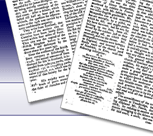Add this eBook to your basket to receive access to all 2,576 records. Our indexes include entries for the spelling day. In the period you have requested, we have the following 2,576 records (displaying 2,341 to 2,350): These sample scans are from the original record. You will get scans of the full pages or articles where the surname you searched for has been found. Your web browser may prevent the sample windows from opening; in this case please change your browser settings to allow pop-up windows from this site. Workers from The Birmingham Small Arms Co Ltd (B. S. A.) who fought in the Great War
(1919)
The Roll of Honour for the firm lists the men who joined his Majesty's forces, giving for each his surname, christian name, and regiment. The names of those killed in the conflict or taken prisoner are noted as such. The list starts with a roll of the B. S. A. "O" Company, 6th battalion Royal Warwickshire Regiment (territorials) who were mobilised for active service at the start of the war 4 August 1914: but this first part gives only surnames and initials, not full names. | Sample scan, click to enlarge
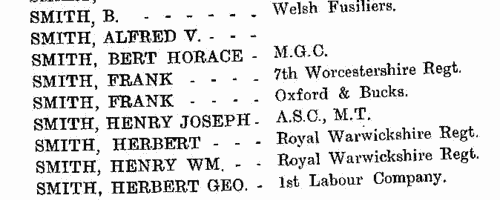
| Workers from The Delta Metal Co Ltd of Delta Works, Dartmouth Street, Birmingham, who fought in the Great War
(1919)
The Roll of Honour for the firm lists the men who joined his Majesty's forces, giving for each his surname, initials, rank and regiment. | Sample scan, click to enlarge

| Shorthand Writers
(1919-1920)
Volume 79 of Pitman's Journal, the weekly devoted to Pitman's shorthand, runs from 4 October 1919 to 25 September 1920. The names that occur in the pages are not only of shorthand enthusiasts, competitors (at home and abroad), contributors and advertisers, but also of those awarded Pitman's Shorthand Teachers Diploma. | Sample scan, click to enlarge

| Associates and Old Students of the Royal School of Mines
(1920)
The Royal School of Mines (Old Students') Association produced this alphabetical register of Associates and Old Students. So far as possible, the compilers gave these details: full name (surname first); dates at the school; record as a mining engineer; military service in the Great War; and current address. In some cases, the entry is transcribed from a previous register, of 1896, no further information having been obtained - such entries are marked with a dagger. * signifies 'Deceased'. | Sample scan, click to enlarge
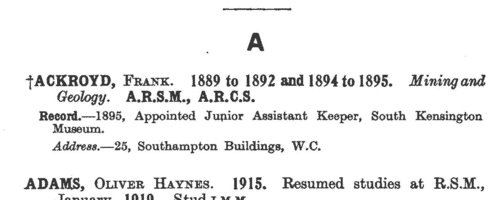
| Naval Officers
(1920)
The alphabetical list of officers on the Active List of the Royal Navy and Royal Marines (RM) and of the Retired and Emergency Officers serving gives: number of ship or where otherwise serving; name (surname, first christian name and initials); rank; and the dates of their seniority. This is the list from the March 1920 edition of the Navy List, corrected to 18 February 1920.
| Sample scan, click to enlarge
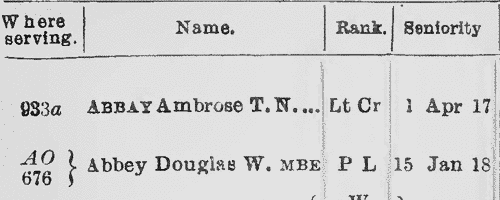
| Shorthand Writers
(1920-1921)
News and notices about Pitman's shorthand, with correspondence, advertisements &c. | Sample scan, click to enlarge
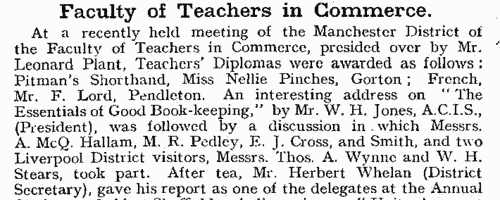
| Boiler Makers and Iron and Steel Shipbuilders: East Cowes (1921)
The monthly report of the United Society of Boiler Makers and Iron and Steel Shipbuilders contains, as well as internal union business, reports of meetings; obituaries; warnings about named individuals falling into arrears, or becoming 'out of benefit'; members 'run out'; subscription sales; new members admitted; second class transferred to first class membership; apprentices admitted; apprentices transferred to adult membership; and 'unapproved' apprentices. Members are normally identified by surname and initial, with membership number as appropriate. These abbreviations also occur: 1st, first class; 2nd, second class; 3rd, third class; A.I.S., angle iron smith; App., apprentice; A.W., acetylene worker; C., caulker; D., driller; H-up, holder-up; P., plater; R., riveter; S.I.W., sheet iron worker. January 1921
| Sample scan, click to enlarge
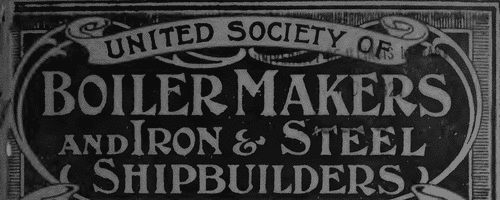
| Boiler Makers and Iron and Steel Shipbuilders: Hartlepool (1921)
The monthly report of the United Society of Boiler Makers and Iron and Steel Shipbuilders contains, as well as internal union business, reports of meetings; obituaries; warnings about named individuals falling into arrears, or becoming 'out of benefit'; members 'run out'; subscription sales; new members admitted; second class transferred to first class membership; apprentices admitted; apprentices transferred to adult membership; and 'unapproved' apprentices. Members are normally identified by surname and initial, with membership number as appropriate. These abbreviations also occur: 1st, first class; 2nd, second class; 3rd, third class; A.I.S., angle iron smith; App., apprentice; A.W., acetylene worker; C., caulker; D., driller; H-up, holder-up; P., plater; R., riveter; S.I.W., sheet iron worker. January 1921
| Sample scan, click to enlarge
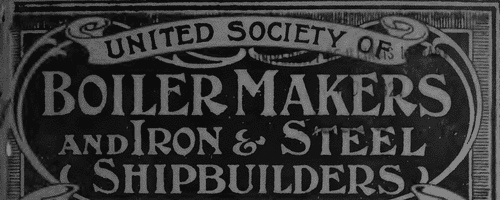
| Boys entering Clifton College
(1921)
Clifton College near Bristol was established in 1862. This edition of the Clifton College Annals and Register for the Old Cliftonian Society by F. Borwick was published in 1925. Boys are listed alphabetically by term of entry, with full names, surname first, in bold. Father's (or widowed mother's) name is given (surname and initials) in capitals, and address. Then there is the name of the house (N. T., North Town; S. H., School House; S. T., South Town), first and last forms, distinctions in school work and games, and month of leaving. Where known, the editor then gave a career summary with month of death; or, if still living, address as in 1925 (in italics). Of course, in the case of boys entering the school in the years immediately before 1925, they were either still at school or their careers were still ahead of them. | Sample scan, click to enlarge
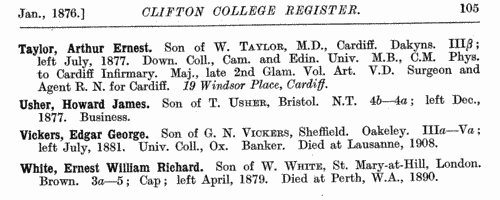
| Boys entering Epsom College
(1921)
The Royal Medical Benevolent College at Epsom in Surrey was founded in 1853 for the orphans of the medical profession, and evolved to become a public school still largely catering for sons of doctors and surgeons. In 1955 this register of pupils, from 1855 to 1954, edited by T. R. Thomson, was published. The sample scan is from 1880. The entries are arranged alphabetically by surname under year of entrance to the school; surname first (in bold), christian names, and then (in most cases), the father's name, occupation and address: then the boy's year of birth (b.), year of leaving (l.), occupation, and, where known, year of death (d.). From 1880 onwards the house to which the boy belonged is also indicated: the boarding houses were Carr (C.), Forest (F.), Granville (G.), Holman (H.), Propert (P.) and Wilson (W.); and Crawfurd (Cr.), Hart Smith (H. S.) and Rosebery (R.) are the houses for day scholars. From 1895 to 1927 there was a junior school, called Lower School (L. S.), taking in boys from the age of 8, many passing seamlessly into the main school at age 12 to 14. From 1920 onwards the pupils' addresses as of 1955 (where living and still known) are added at the end of each entry. This is the index to the year 1921, when the Reverend Canon Walter John Barton was headmaster. | Sample scan, click to enlarge

|
Research your ancestry, family history, genealogy and one-name study by direct access to original records and archives indexed by surname.
|

